- Home
- Blog
- Web Design
- A Guide to Social Logins
A Guide to Social Logins
-
 12 min. read
12 min. read
-
 William Craig
William Craig CEO & Co-Founder
CEO & Co-Founder
- President of WebFX. Bill has over 25 years of experience in the Internet marketing industry specializing in SEO, UX, information architecture, marketing automation and more. William’s background in scientific computing and education from Shippensburg and MIT provided the foundation for RevenueCloudFX and other key research and development projects at WebFX.
This reference guide will discuss what social login is, look at social login examples in web apps, and provide links to relevant documentation and tutorials.
What is Social Login?
Social login gives users the option to sign-up and login on app using their account on a social network like Facebook, Twitter, or Google+. Here’s a beautiful social login example on the to-do list app Wunderlist: 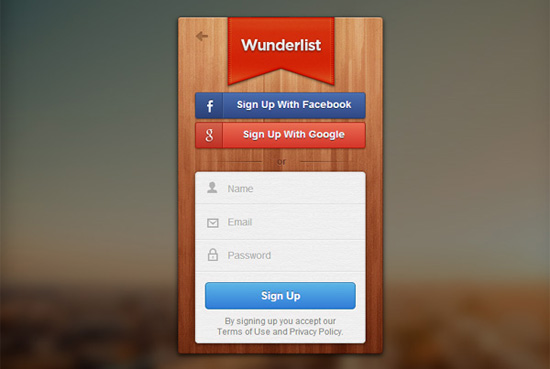 The app allows its users to sign-up and login using Facebook, Google, or by providing a username and password. Social login is a type of single sign-on, a software design pattern that allows people to use the same username and password to access different systems.
The app allows its users to sign-up and login using Facebook, Google, or by providing a username and password. Social login is a type of single sign-on, a software design pattern that allows people to use the same username and password to access different systems.
Social login is also called social sign-in or social sign-on.
Social Login Examples
Let’s look at some real-world examples of web apps using social login.
Example 1: Pinterest
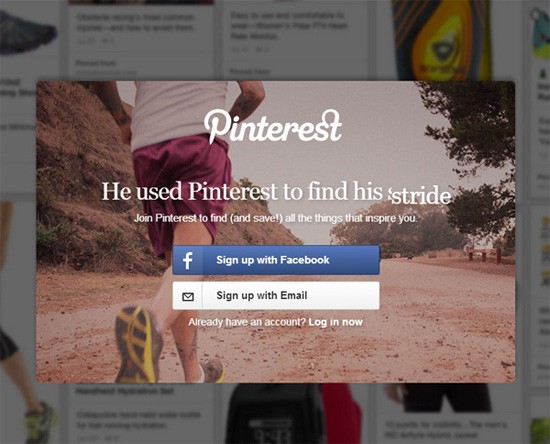 The social image board gives users the option to sign-up and connect their Pinterest account with Facebook. Pinterest, with permission, can post on their users’ Facebook timelines, giving their product more exposure and possibly more sign-ups from friends of their users.
The social image board gives users the option to sign-up and connect their Pinterest account with Facebook. Pinterest, with permission, can post on their users’ Facebook timelines, giving their product more exposure and possibly more sign-ups from friends of their users.
Example 2: StumbleUpon
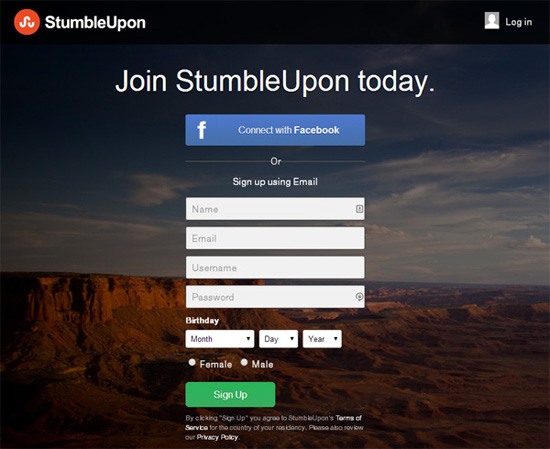 StumbleUpon’s (SU’s) social login option is an example of how social logins can make the onboarding process easier for people. Signing up using a Facebook account requires less effort compared to SU’s email sign-up option which asks users to fill out 8 input fields: name, email, username, password, birth date, sex, and birth date.
StumbleUpon’s (SU’s) social login option is an example of how social logins can make the onboarding process easier for people. Signing up using a Facebook account requires less effort compared to SU’s email sign-up option which asks users to fill out 8 input fields: name, email, username, password, birth date, sex, and birth date.
Most of this information can be attained from a person’s Facebook profile if they already have them up there, and their SU username can be auto-suggested based on their Facebook ID.
Example 3: Canva
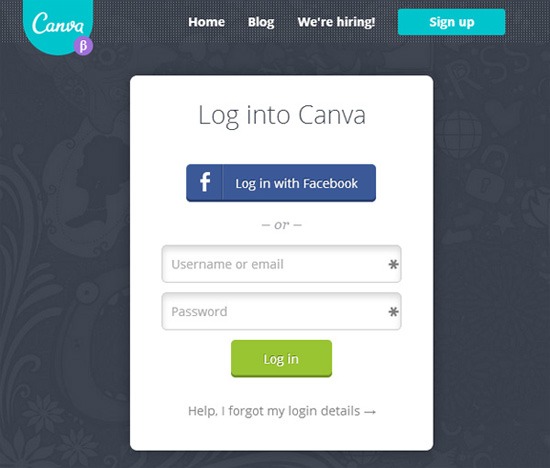 Canva is a design collaboration app. The social nature of web-based collaboration makes a Facebook login a logical option. Additionally, since Canva is relatively new (it just launched 6 months ago) people who trust Facebook with their username/password credentials more than the new app might be more compelled to sign-up.
Canva is a design collaboration app. The social nature of web-based collaboration makes a Facebook login a logical option. Additionally, since Canva is relatively new (it just launched 6 months ago) people who trust Facebook with their username/password credentials more than the new app might be more compelled to sign-up.
Example 4: RunKeeper
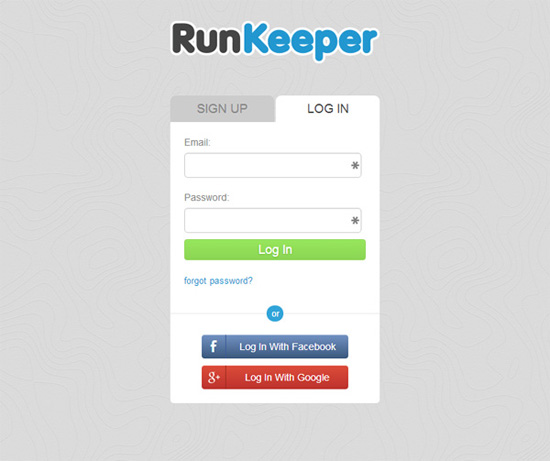 Many studies show that social support has health/fitness benefits.
Many studies show that social support has health/fitness benefits.
That could be a reason why it’s a good idea for RunKeeper — a mobile app for tracking your running activities — to give users the option to sign-in and connect their accounts to their Facebook and Google+ networks. Posting progress and activities on social networks can be an avenue for social encouragement, motivation, and support for runners using the app.
Example 5: Karma
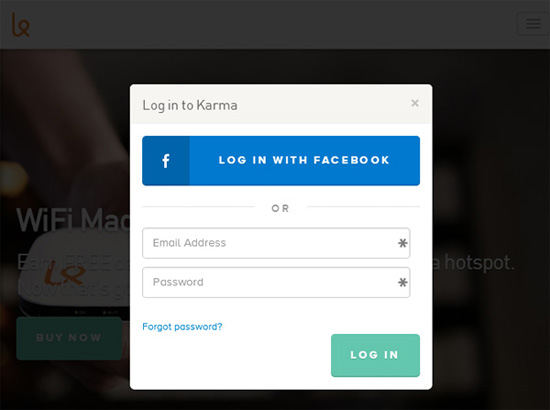 Karma is a pocket-sized WiFi hotspot that allows people around you to connect and share your wireless Internet connection. Karma users using Facebook social login allows the company to store and use the person’s Facebook profile data (photo, email address, Facebook ID).
Karma is a pocket-sized WiFi hotspot that allows people around you to connect and share your wireless Internet connection. Karma users using Facebook social login allows the company to store and use the person’s Facebook profile data (photo, email address, Facebook ID).
With opt-in permission, web apps can use information sourced from social media accounts to automatically pre-populate user account information so that the person doesn’t have to, for instance, manually upload a photo or input their email address. But when they launched, reviews by early adopters and tech news sites like TechCrunch and Gizmodo criticized the requirement of Facebook authentication as a condition to using Karma. So, now, Facebook social sign-in is an option on Karma, but not a requirement.
This clues us in to a best practice: Give users a choice of whether or not they would like to connect their social network to your app.
Example 6: Airbnb
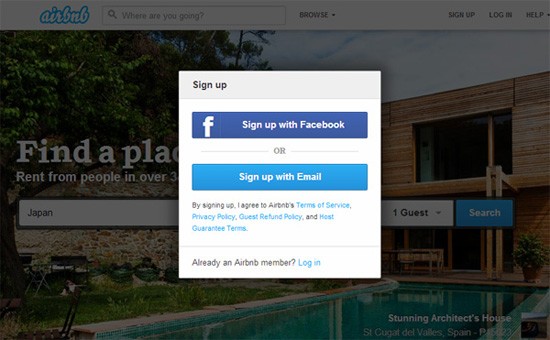 On Airbnb, users who connect their Airbnb account to their Facebook account get additional privileges compared to those who don’t. Benefits include added trust, safety and verification, which is required for booking or hosting in some cases.
On Airbnb, users who connect their Airbnb account to their Facebook account get additional privileges compared to those who don’t. Benefits include added trust, safety and verification, which is required for booking or hosting in some cases.
Example 7: Buffer
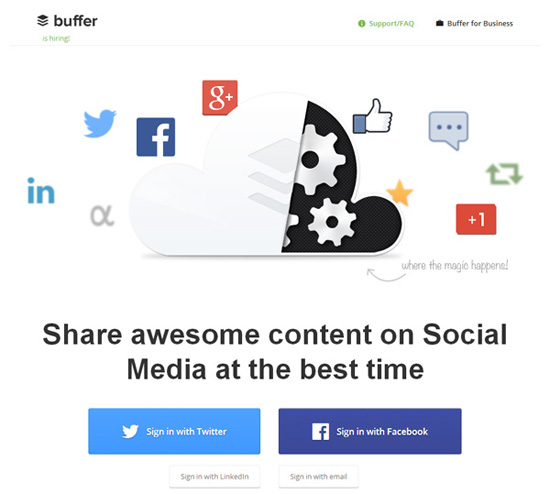 In a few cases, social login is mandatory. This is true for web apps like Buffer, which helps you manage your social media posts.
In a few cases, social login is mandatory. This is true for web apps like Buffer, which helps you manage your social media posts.
In order to do its job, Buffer needs permission to access your social media accounts.
Example 8: Quora
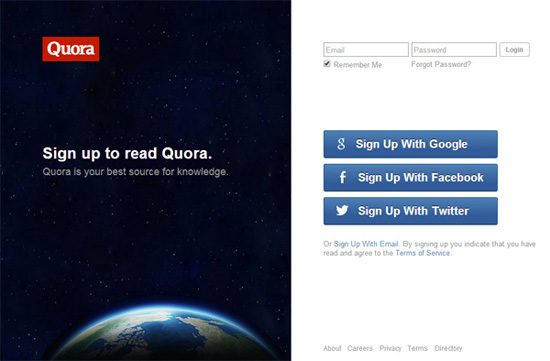 On Quora, creating an account is required to access all of the site’s content. According to Quora, requiring people to sign-in is because the site “depends on everyone being able to pitch in when they know something” and — the thinking goes — forced sign-in reduces the tendency of individuals to lurk without chipping in. Forced sign-in on Quora has been criticized by journalists and some Quora users.
On Quora, creating an account is required to access all of the site’s content. According to Quora, requiring people to sign-in is because the site “depends on everyone being able to pitch in when they know something” and — the thinking goes — forced sign-in reduces the tendency of individuals to lurk without chipping in. Forced sign-in on Quora has been criticized by journalists and some Quora users.
However, the social sign-in option on Quora at least makes the process quicker for people who take advantage of social login. Here are other sites that use social logins:
Example 9: Weebly
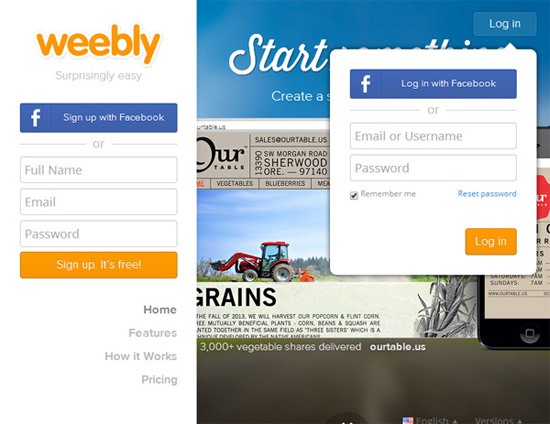
Example 10: Gumroad
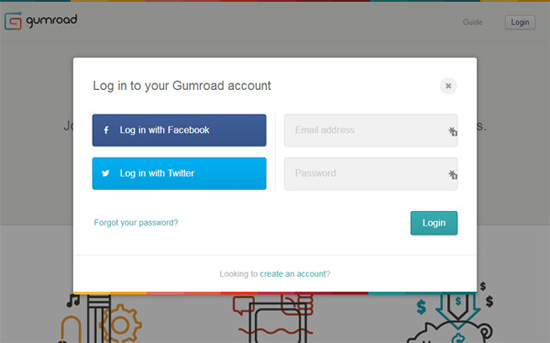
Example 11: Asana
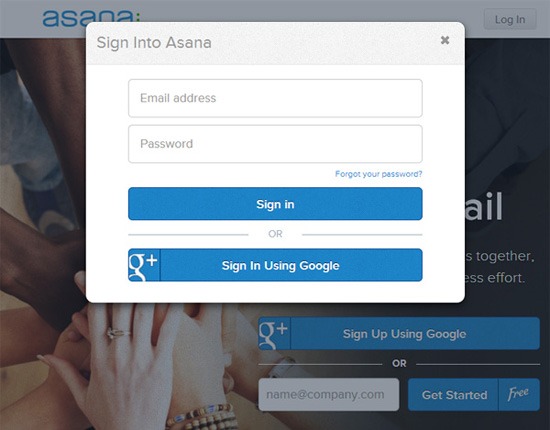
Example 12: Foursquare
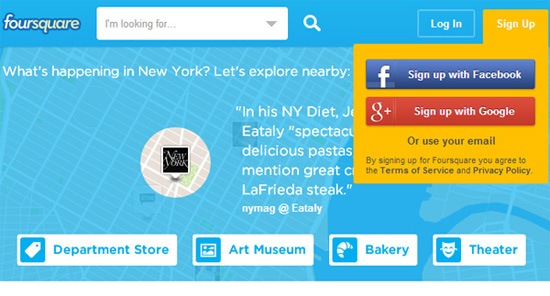
Example 13: Fitocracy
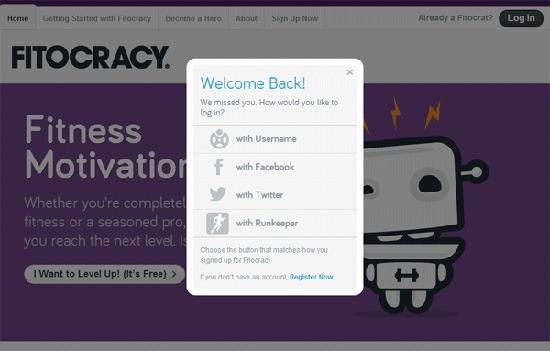
Example 14: hackpad
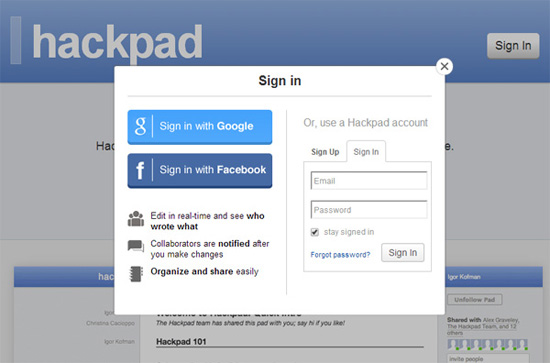
Example 15: Map your runs
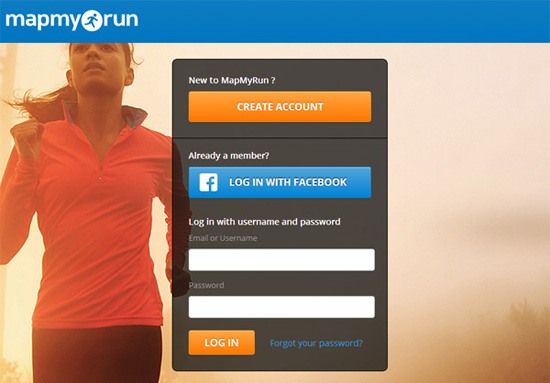
Benefits of Social Login
As we can see from the examples above, users and developers can gain several advantages by using social login.
Benefits for Users
Users get these advantages: Ease of signing up to a website Social logins make signing up to sites and apps quicker because it usually involves clicking a few buttons. Predictability of the sign-up process Using social login give users who regularly use the method a streamlined and uniform process regardless of which site their signing into.
Manage fewer accounts Using social login means users will have fewer web app accounts to deal with. Trust It might be hard for some site visitors to get the feeling of confidence they need to compel them to provide their personal information to an unknown site. People might be more comfortable having their information handled by familiar social networking platforms they already trust.
Benefits for Developers
Developers get these advantages: Authentication of users For apps, allowing social login can provide an additional layer of verification that the user is a real person.
It’s free (under most conditions) Implementing social logins entails using APIs like Google+ API or Facebook Login that are usually free and publically accessible. However, some APIs have a quota for how much a third-party app can use them, and the app developer might be required to pay if they need more resources than the limit allocated to them. Individualized user experiences Users who choose to connect their social network to your app allows you to leverage existing information in their social graph that can improve their experience while using your app.
Pre-population of blank state inputs Users who choose to sign-in to your app using their existing social media account gives you the ability to auto-suggest or auto-populate their account settings (e.g. profile photo, email address, phone number) if the information is present in their social media account. This in turn can ease or improve the first-run blank slate experience.
Make your app more social and engaging Social logins can connect your app to your users’ social networks (if they permit you), giving your app more exposure and engagement opportunities. Reduce failed login attempts and forgotten password requests If a person is already logged into Facebook (for example), they don’t need to retype or remember their password to access your system. Spam protection Requiring authentication can slow down spam because signing into the system requires third-party verification.
Spam protection also comes in the form of the social network’s more mature spam-prevention technology. It just makes sense for social apps Some apps simply need to use social login. For example, at JustUnfollow and Buffer (mentioned earlier), which are tools for helping you manage your social media account, social login is required in order for them to do their jobs.
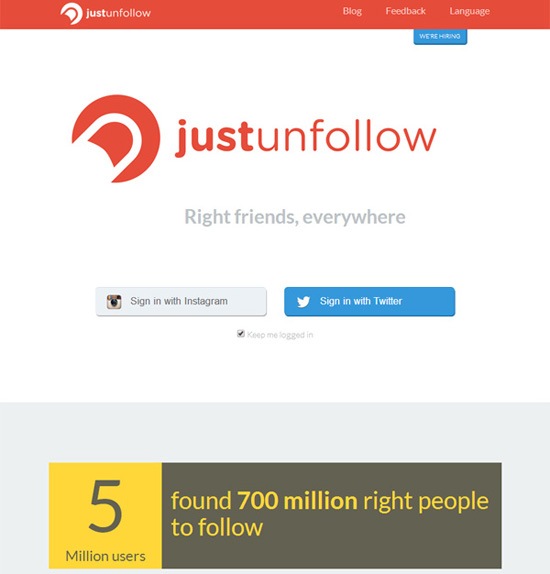
Why You Wouldn’t Use Social Logins
There are several reasons for choosing not to provide social logins as an option for your users.
Dependence on External Platforms
Using any third-party service subjects you to terms-of-use changes. Terms can (and do) change. Restrictions are often put into place.
Web services get closed down permanently. If your mission-critical processes rely heavily on third-party services, you might find yourself in trouble if – for instance – Facebook, Google, or Twitter suddenly make changes to their platforms that restrict your use of their services. Some apps have shut down or have failed due to API changes (e.g.
Privacy Concerns
It’s been revealed that social platforms use their APIs as a source of user data outside of their own domains. One such example is the Facebook Like button that the social network uses to learn about people’s browsing behavior. Facebook Login, the service allowing other sites and apps to use Facebook as a mode of user authentication, is different from the Like button, but we could reasonably come to a conclusion that analogous data-mining techniques could be used by the platform.
Dealing with Multiple Account Types
Developers will need to create a system that’s able to negotiate between normal email sign-ins and various social sign-ins.
Decision Paralysis
It’s been shown in some studies that too much choice can negatively affect conversion rates.
The idea can apply to the situation where you’re presenting users with several methods for creating an account on your app.
Dilution of Your Brand Identity
By showing Facebook-, Google-, and Twitter-branded buttons in your login forms, we could argue that this competes with your own business identity. This is what Oliver Reichenstein, founder of strategic design company, iA, says about social media buttons: “What we know for sure is that these magic buttons promote their own brands — and that they tend to make you look a little desperate.”
It’s Not Worth It
In a discussion about social login, Aarron Walter, director of UX design at MailChimp, concluded that the benefits of allowing their users to sign-in using Facebook or Twitter didn’t provide the company with enough incentives to keep the social login option. They witnessed only 3.4% of their users using social logins, which is not worth negative impact of diluting their own brand identity, according to the blog post.
Tips for Social Login Implementation
Based on my observations, here are tips for those who are considering social login options.
Social Login Should be Optional
As discussed earlier, apps and services requiring people to connect their social media profiles are criticized for the decision.
Social login should be an option, not a requirement.
Limit the Number of Social Login Options
Decision paralysis could come into play if you provide too many social login options, which in turn could affect user acquisition. Stick to the most popular options, which are currently Facebook, Twitter, and Google.
Have an Exit Strategy
Always plan for the event that the social login platforms you’re using suddenly decide to restrict or remove your access. It has happened in the past.
It could happen in the future.
Popular Social Login API Docs
Here is a reference table for popular social login APIs:
| Platform | Link to API documentation |
|---|---|
| Facebook Login | |
| Google+ Sign-In | |
| Authentication | |
| Authentication | |
| Application-only authentication |
Social Login Tutorials and Resources
- How to Authenticate Users With Facebook Connect
- Facebook Login Overview
- FBConnect Tutorial
- Login with Google Account to Website
- Getting Started on the Google+ API
- LinkedIn API Quick Start Guide
- Creating an Application using LinkedIn Platform in 3 Easy Steps!
- How to Authenticate Users With Twitter OAuth
- Implementing Sign in with Twitter
Related Content
- Getting Users to Sign Up: Factors in Design and Content
- 10 Tips for Optimizing Web Form Submission Usability
- Related categories:Web Development and Web Applications
-
 President of WebFX. Bill has over 25 years of experience in the Internet marketing industry specializing in SEO, UX, information architecture, marketing automation and more. William’s background in scientific computing and education from Shippensburg and MIT provided the foundation for RevenueCloudFX and other key research and development projects at WebFX.
President of WebFX. Bill has over 25 years of experience in the Internet marketing industry specializing in SEO, UX, information architecture, marketing automation and more. William’s background in scientific computing and education from Shippensburg and MIT provided the foundation for RevenueCloudFX and other key research and development projects at WebFX. -

WebFX is a full-service marketing agency with 1,100+ client reviews and a 4.9-star rating on Clutch! Find out how our expert team and revenue-accelerating tech can drive results for you! Learn more
Make estimating web design costs easy
Website design costs can be tricky to nail down. Get an instant estimate for a custom web design with our free website design cost calculator!
Try Our Free Web Design Cost Calculator


Web Design Calculator
Use our free tool to get a free, instant quote in under 60 seconds.
View Web Design Calculator
Proven Marketing Strategies
Make estimating web design costs easy
Website design costs can be tricky to nail down. Get an instant estimate for a custom web design with our free website design cost calculator!
Try Our Free Web Design Cost Calculator
What to read next




